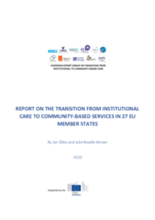Executive Summary
Introduction
Since 2009, numerous stakeholders at European and national level have been working on promoting social inclusion, combating poverty and discrimination, and making the shift from institutional to community-based care a reality for a variety of target groups in European countries.
There is strong evidence from research over many decades that community-based alternatives can provide better outcomes. In addition, costly improvements in the physical conditions of existing institutions or the division/redesign of existing institutions into smaller units fail to change the institutional culture and make it more difficult to close these institutions in the long term.
Previous research showed that such an institutional culture is often still present in smaller community-based residential services and relatively resistant to change even in the countries that started the process of deinstitutionalisation much earlier than others. The report of the Ad Hoc Expert Group on the Transition from Institutional to Community-based Care noted the difficulties in defining what an institution is and focused instead on institutional culture. They use the following definition in the report: “any residential care where:
- users are isolated from the broader community and/or compelled to live together;
- these users do not have sufficient control over their lives and over decisions which affect them;
- the requirements of the organisation itself tend to take precedence over the users' individualised needs.”
The aim of this report was to collate information about policies and plans, changes over time, strengths and areas of concerns relevant to advancement in deinstitutionalisation in 27 EU countries and for six target groups: adults with disabilities, adults with mental health problems, children (including children with disabilities), unaccompanied or separated migrant children, homeless persons and older adults. However, as identified in other recent studies, very limited information (either official statistics or research) is available for any country in Europe on the extent to which people participate in their community, how well they are accepted as part of their community, the choice they have over living situation, whether they have choice and control in their lives more generally and have freedom to leave where they live, the quality of the support they receive, whether they feel treated with dignity and respect, etc.
In the absence of such data, we have to resort to looking at living situation. Whilst it is accepted that living in an ordinary house, dispersed in the community is not sufficient for a better quality of life or full citizenship, especially for those with more severe and complex needs, it is a necessary condition. Just looking at how many people are living in the community compared to in institutional settings, does not in itself tell us much about their quality of life or whether they have choice, control and are participating as full members of their community. However, having a home in the community just like everyone else is the first step to being present and visible in the community, which in turn is the first step to participation and being seen as a valued member of the community. Where possible we will differentiate between different models of services referred to as “community based” and between different services referred to as “institutions”. For adults, we will try to differentiate between independent/supported living (defined as where housing and support are separate), smallscale community-based services where people may not own or rent their own home but otherwise live in an ordinary home in the community, and larger scale residential services. For children we will differentiate where possible between living in a family setting (with biological, adopted or foster families) from any other type of arrangement.
This report will look at both change over time with a particular focus on evidence related to the closure of institutions and the development of alternative arrangements in the community, as well as broader actions to reform legislation and public services. To some extent, the report also reflects the impact of European Union strategy and actions including the European structural and investment funds, on advancing the right to live independently and to be included in the community.

